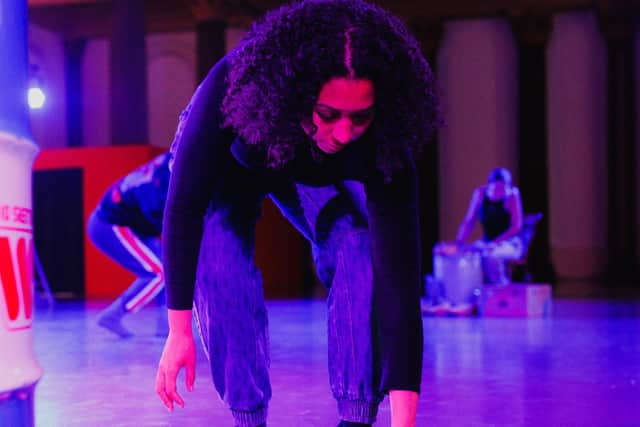Take Me Somewhere: A festival where ideas can thrive
Whereas most festivals are named after the place they occupy, Take Me Somewhere is more a statement of intent than location. Founded in Glasgow in 2017, this biennial arts festival sets out not just to entertain and engage, but to transform. You enter a performance feeling a certain way about the world and leave with your head turned.
“In one sense Take Me Somewhere is quite literal because we have performances across the city,” says artistic director, LJ Findlay-Walsh. “And then there’s something about celebrating the present to understand the future. So it’s actually taking us somewhere in terms of how we envisage a way forward.” From larger shows performed on the main stage at Tramway to smaller installation pieces, Findlay-Walsh tries to ensure the festival’s programming has “something in there for absolutely everybody”.
Advertisement
Hide AdAdvertisement
Hide AdSometimes, however, the best way to really connect with an audience is to involve them. “As much as I absolutely love seeing exciting works of scale, the performances that only a small amount of people will ever be able to participate in can be so transformative,” says Findlay-Walsh. “So having a balance of both these things within the festival is really important.” In the final week of Take Me Somewhere, three works in particular allow people to get up close and personal with an artists vision, and reflect on their own experiences.


TransMission: Sissy TV by Nando Messias is an archive of costumes and shoes from two decades’ worth of performances. They capture what it means for Messias to be trans, to feel invisible and not see themselves reflected in the world. “But the more personal the experience I'm sharing, the more universal it seems to be,” says Messias. “I don't really know why that is, although I have a feeling it has something to do with vulnerability, fragility, and the exposure of something utterly human that everyone can relate to.” For Messias to share their story, it was essential that people could touch the material, smell the perfume and try on the shoes.
“The archive lives in the lipstick traces and smell of perfume left in the dresses I wore in performance, the broken heel of a shoe, the badly mended tear of a costume,” explains Messias. “These things can only be seen from very close proximity. It’s also important to me that audience members experience my archive through their bodies, that they can touch, grasp and try on and understand what it is to be trans from a personal, physical and bodily perspective.
“This is an urgent endeavour for people like me in a time and place where being trans has become unsafe and at times even dangerous. I’m challenging the notion that we are a trend and never existed before. We have always been here but our stories and memories have been kept in the dark. This project is trying to bring our lives and histories into the light.”
Ashanti Harris is taking a similar approach with her work Walking with The Ancestors in Joy and Healing. An interactive, guided experience centred in Black histories, audiences are invited to move through the space hearing, seeing and touching objects. “It’s participatory but I’ve tried to create an installation which gives each audience member space to have a personal experience,” says Harris. “How much you physically respond is totally up to you and there is always an option to explore the provocations in your imagination instead.” Originally trained in sculpture, and now also working with dance, text and sound, Harris has been inspired, in part, by Caribbean carnivals.
“In carnival, everyone participates whether you are a performer, maker or passer-by,” says Harris. “Walking and dancing down the road, celebrating identity and connecting with ancestors, whilst also questioning societal structures and imagining alternate possibilities of future ways of being. Walking with The Ancestors in Joy and Healing is a much quieter kind of meditative experience, but the intention is the same.”
Both Messias and Harris will welcome groups of people into their performance space, but over at the Mitchell Library, Adam Kinner and Christopher Willes are keeping things far more intimate. Designed for one audience member at a time, MANUAL is the duo’s response to the fast-paced media that bombards our brains daily, and a love letter to libraries which are often under threat of closure.“The slowness and anything-goes energy of a library seems radical in some ways,” says Kinner. “Books, desks, free unbranded and uncommercialised information and you don't have to pay to be there. There’s something powerful about entering these spaces and saying ‘let's slow down and see what this place has to offer’.”
Advertisement
Hide AdAdvertisement
Hide AdSilently guided through the public space, participants will engage in a series of events via headphones and written notes. There is no ‘performer’ as such, rather the guide sits alongside you, as you read and explore together to create a manual for slowing down. “Early in the process we showed the piece to a friend who said it was like the opposite of Instagram,” says Willes. “A nice joke, but it stayed with us. Nothing specifically against Instagram, but we often feel that the sensorial flatness of social media increasingly affects how we perceive the world. In MANUAL, we try to bring back a sensory encounter with the spaces, people and materials around us. It has the power to slow us down and bring us deeper into our own experience.”
Take Me Somewhere, various venues, Glasgow until 28 October. https://takemesomewhere.co.uk
TransMission: Sissy TV, Tramway, Glasgow, 26-27 October
Walking with The Ancestors in Joy and Healing, Tramway, Glasgow, 28 October
MANUAL, Mitchell Library, Glasgow, 26-28 October